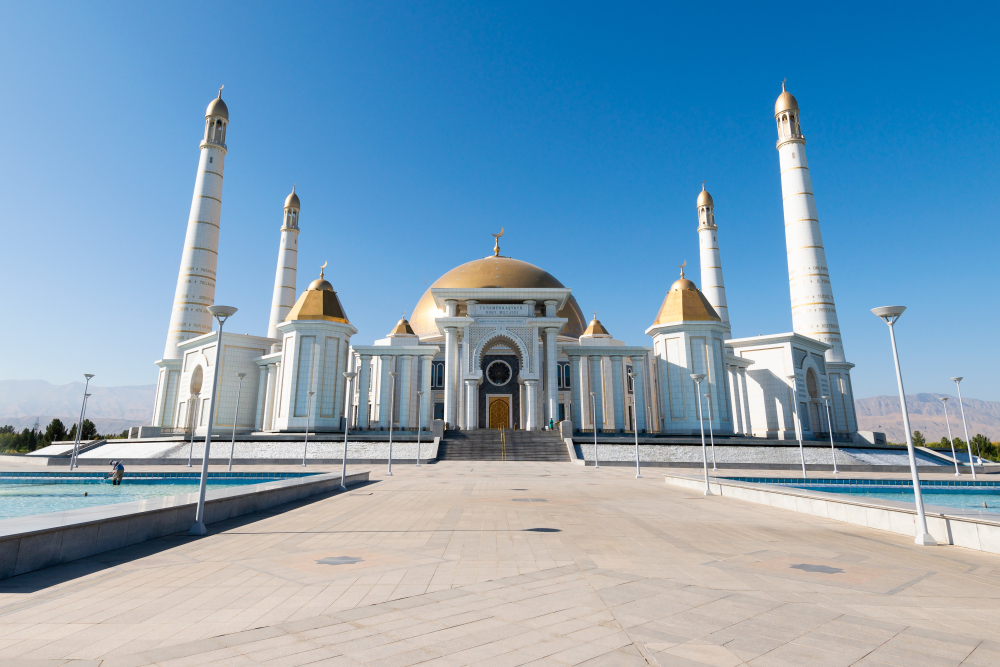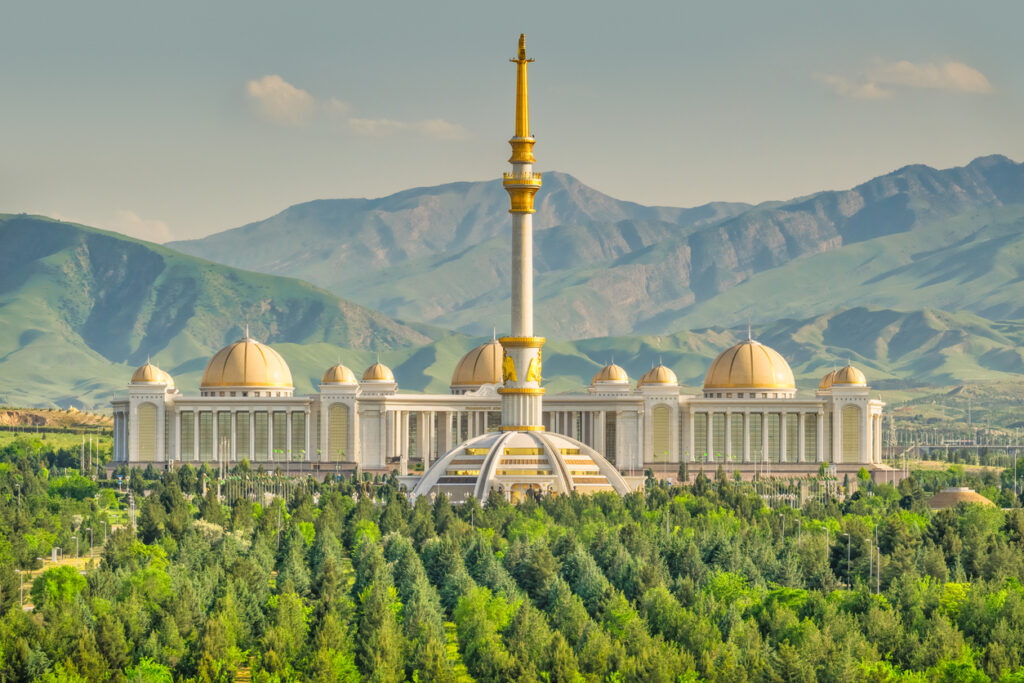A guide to Ashgabat, Turkmenistan
Your flight descends through the thermal haze of the Karakum Desert. Below, white marble buildings rise in geometric symmetry, glinting under the sun. The airport in Ashgabat is a giant avian-shaped building. You step off the plane into a terminal, sleek and oversized, that is nearly empty, its silence echoing like an abandoned space station. You ride into a city that is both hyper-clean and eerily vacant. There’s a cleanliness to Ashgabat that edges into the unreal. Like a theme park after closing time.
You enter a simulation of a city. The white marble buildings shimmer under the sun like glitched reflections of an unmade utopia. There are few people on the streets. CCTV cameras, disguised as cybernetic flowers, follow you. Surveillance is invisible, but you feel it.
The streets are wider than runways, and they are eerily empty. Black cars are banned. Cars must be white, silver, or pastel. Dirty cars are forbidden—there are washing stations at the edge of the city to keep them clean. Checkpoints outside the city inspect for grime. .
But let’s rewind.
Here is some recent history. Turkmenistan’s first president, Saparmurat Niyazov ruled the country from its independence in 1991 until his death in 2006. He reinvented himself as the Father of the Turkmen and crafted Ashgabat not just as a capital, but as a monument to himself. He was the original architect of this city.
The capital of Turkmenistan is full of monuments to the first president. His statues—cast in gold, or wrapped in it—are everywhere. They stand in marble plazas and in front of palatial ministries. There’s a statue of Niyazov in gold, striding forward, arms outstretched. Another statue shows him as a golden child nestled in the lap of his bronze mother.
‘I’m personally against seeing my pictures and statues in the streets,’ he said, ‘but it’s what the people want.’
Niyazov declared himself president for life, banned beards, ballet, and lip-syncing, and in a country baking under desert heat, he dreamed of building an ice palace, a solid block of ice, permanently cold, where children could learn to skate.
His face was on everything: currency, cologne bottles, vodka labels, tea packets. He banned opera. He banned recorded music at weddings. He banned radios in cars. He launched books into space and banned gold teeth. Niyazov renamed the months and days of the week after his family members. He renamed January after himself. April became Gurbansoltan, in honor of his mother. He renamed bread after her too.
Ashgabat is not a place, it’s a construct, a cityscape coded in fantasy. A city of silence and statues, white marble and deep surveillance. The silence is engineered. Here the sky has no memory. Even the air feels filtered. Ashgabat is where the future already happened.
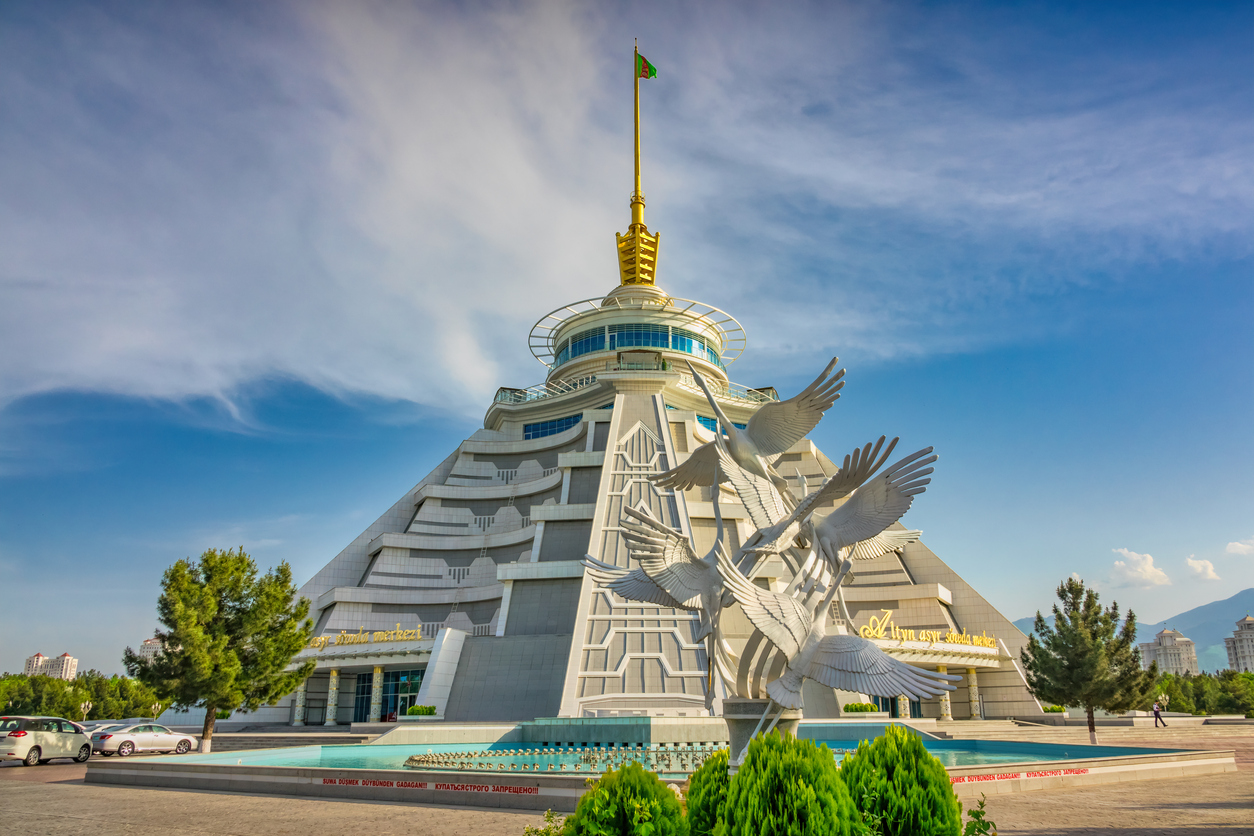
Start your journey at the Ruhnama Monument, a pink-green book-shaped monolith. Every evening at 8 pm the monument opened up like a pop-up book, playing audiovisual sermons to the skyline. Written by Niyazov, Ruhnama means ‘The Book of the Soul.’ Ruhnama is not just a book. It’s an operating system, a blend of moral code, science denial and cosmic destiny. The book was required reading in schools and universities. Students studied it more than math. Adults recited it in offices. Imams were ordered to shelve it beside the Quran. Those who refused had their mosques demolished.
For over a decade, citizens were required to memorize the book. It was mandatory reading to pass your driving test. When Niyazov changed the calendar, September became the month of Ruhnama. The year 2005 was renamed after the book as well. Ruhnama was launched into space aboard a Russian rocket in 2005. It will be orbiting Earth for the next 150 years.
The city’s boulevards—eight lanes wide, and mostly empty—are lined with marble ministries and LED billboards. Nearby, the Independence Monument thrusts skyward. Marble stairs lead up to a yurt-shaped base where a massive concrete tower seems to rise from the city like an alien relic.
Around it, golden warriors and ancient rulers emerge from history like avatars in a state-sponsored RPG. The column is topped by a crescent moon and five stars—symbolizing the unity of the five Turkmen tribes. An observation deck peers over the city, offering a view of what could be the loading screen for a utopian city-builder game.
At the city’s southern edge you pass the Turkmenbasy Ruhy Mosque. It’s part mosque, part moonbase, a house of worship and a state-sponsored spectacle. The largest mosque in Central Asia, it is capable of holding 10,000 worshippers. On the walls Quranic verses are engraved together with Ruhnama quotations. Adjacent lies Niyazov’s mausoleum. He rests under a dome nearly identical to the mosque.
Later you visit the Monument to Neutrality. This rocket monument topped with a golden man in a suit was a rotating tribute to Niyazov.
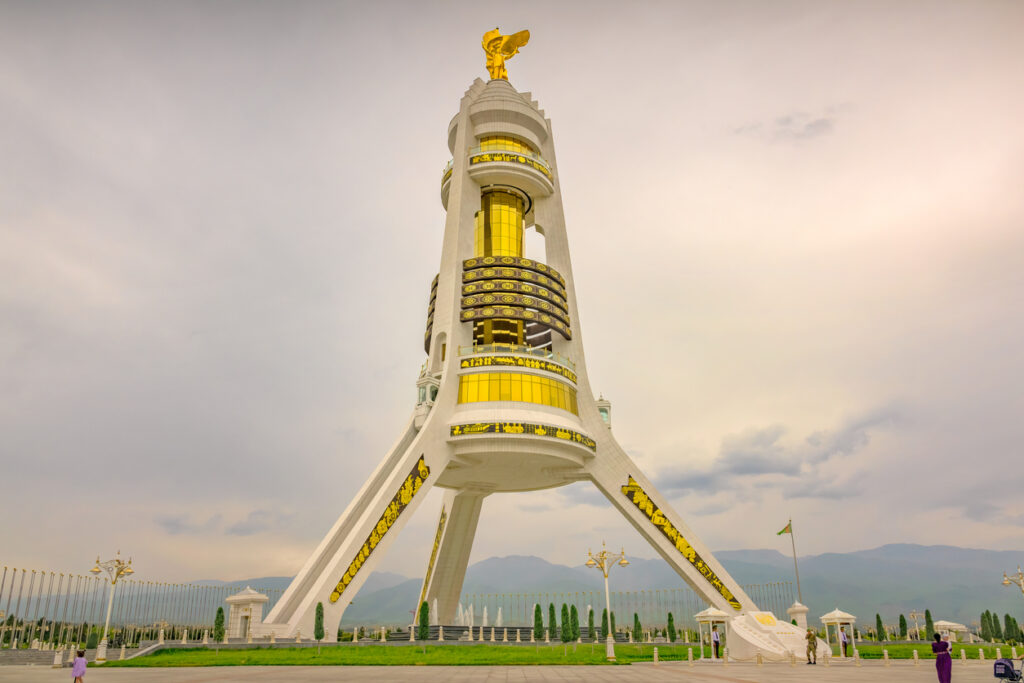
Crowned with a gold statue of the president, it was engineered to rotate and face the sun at all hours. Commissioned in 1998 by Niyazov, this gleaming 75-meter-tall monument commemorates Turkmenistan’s official stance of neutrality on the world stage. It’s observation deck offers panoramic views over Ashgabat’s skyline.
The country’s second and current president is Gurbanguly Berdymukhamedov. He is known as Arkadag the Protector. Once a dentist, then a health minister, now a post-Soviet pharaoh, he dismantled Niyazov’s cult only to erect one of his own.
In 2015, he unveiled the Golden Horse Monument. The 24-karat gold statue captures him mid-gallop on a stallion, clutching a white dove, on a cliff of white marble.
Berdymukhamedov has cast himself as action-hero savior. He pilots fighter jets and races Bugattis through the capital. He drives tanks and fires assault rifles. He lifts gold bars during cabinet meetings while his ministers applaud.
Entire museum floors are dedicated to bizarre photoshopped images of Berdymukhamedov. In one, he is surrounded by golden puppies; in another, he is riding a desert stallion. One of his trophies at the National Museum of History and Ethnography celebrates no known accomplishment. It is a massive white-and-gold plastic trophy with no stated purpose. No name or inscription.
The president has a flair for entertainment. He appears on state TV playing basketball while riding a bicycle, shooting baskets from the saddle. He pens national anthems which he then conducts mass choirs to sing. He stars in his own synth-pop music videos.
The tour now takes you to the Alem Entertainment Center for some controlled fun. The UFO-shaped structure is the world’s largest indoor Ferris wheel. The Ferris wheel is perched on a six-story leisure complex featuring bowling alleys, laser tag, and replicas of space stations.
Next you drive past the Alabay Statue. Berdymukhamedov erected a 20-foot gold statue of his favorite dog, the Central Asian shepherd dog. The gilded monument sits on a roundabout and the pedestal features a curved LED screen playing loops of the dog walking on the grass. The president wrote a book about the dog and declared a public holiday in its honor. You’ll find the dog honored in songs, postage stamps, and state-sponsored lullabies.
Turkmenistan has a national holiday for melons. The second Sunday in August is Melon Day, a celebration of the country’s export. The city counts 24 public holidays, including Melon Day, Carpet Day, Horse Day, Neutrality Day, and Dog Day. These are solemn, state-endorsed expressions of national pride. During these holidays there are some interesting things to see in the city. You can watch a synchronized cycling parade or a beauty pageant for horses.
Berdymukhamedov has a fixation on horses. He is an equestrian champion who declared a national holiday for the animal. Here, horses enter beauty contests, wear garlands, and grace postage stamps and currency.
The president penned a rap song about horses. He wrote books and poems to them, called them his ‘brothers.’ At Day of the Horse celebrations, a choir of thousands sing his lyrics in a giant ceremonial yurt. His book The Flight of Celestial Race Horses opens with: ‘I won’t call you horse, I would call you brother.’
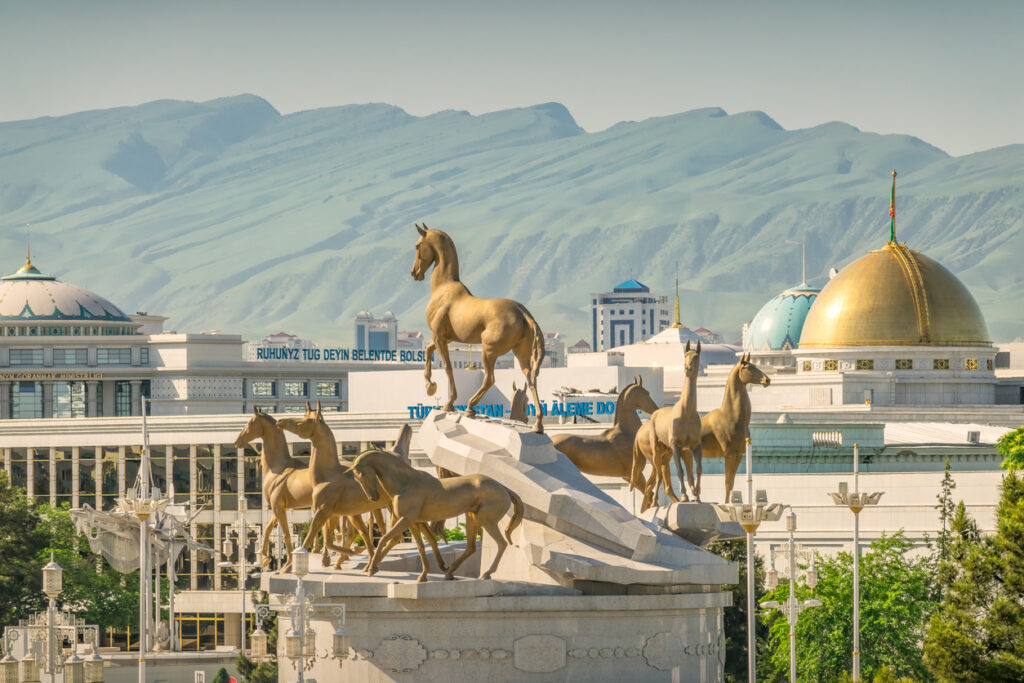
In the evening the wide boulevards, empty of traffic, shimmer with ambient fluorescent light. The city’s stillness hides the strange machinery beneath. You walk Independence Square. Buildings are backlit in color-changing lights. Everything is lit with a soft glow. The square is filled with timed fountains, statues, and a large screen showing men applauding the president on loop.
Later you come to the Palace of Happiness, a hexagonal spaceship that serves as the city’s marriage registry. It looks like an interstellar embassy. Here couples get married under geometric light displays and mirrored surfaces. Brides and grooms dance beneath a globe ringed with stars and adorned with a giant portrait of the president. Newlyweds must pose in front of his portrait for photographs. There are halls for weddings of every scale—from intimate unions to 1,000-guest mega-ceremonies. There are shops, beauty salons, seven banquet rooms and a 22-room hotel. The wedding palace is a gleaming space-age edifice. Glowing with pastel LED lights at night, it looks like it was designed by an alien architect.
